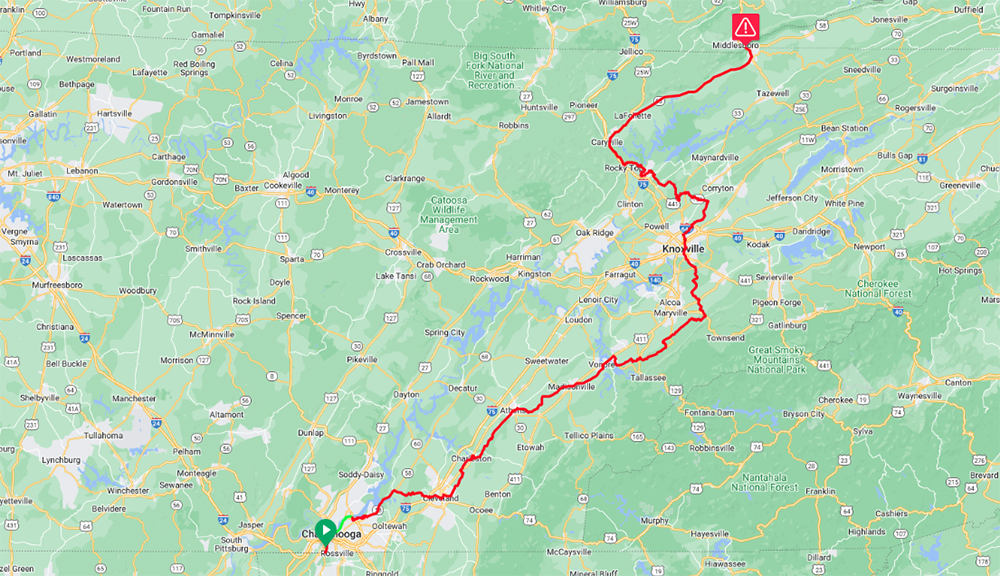The U.S. Bicycle Route System now runs through Chattanooga following the dedication of the Tennessee section of U.S. Bicycle Route 21, which spans 1,043 miles north to south from Cleveland, Ohio, through Kentucky and Tennessee to Atlanta, Georgia.
Consisting of publicly accessible bicycle travel routes designated at the state and federal level, the U.S. Bicycle Route System is a national cycling network similar to the interstate numbered highway system for motorists. The Tennessee portion of USBR 21 runs north from Chattanooga up through small towns including Cleveland, Calhoun and Athens and then up through Knoxville. After passing the Great Smoky Mountains National Park, the route heads north around Norris Lake and up to Cumberland Gap National Historical Park near the Kentucky border.
U.S. Bicycle Routes may be on paved or gravel roads or trails suitable for bicycle touring. State departments of transportation apply to nonprofit American Association of State Highway and Transportation Officials for designation of routes, which are planned with the help of local cycling organizations and volunteers.
The national Adventure Cycling Association provides staff to assist state departments of transportation in developing and designating routes with technical assistance, coordination and resources.
To be considered for designation, potential routes must connect at each end to another state, international border or existing U.S. Bicycle Route, according to the Adventure Cycling Association website.
"It's intended as a long-distance bicycle travel network connecting urban and rural destinations, whether those are communities or tourism destinations," says Jennifer Hamelman, Adventure Cycling Association U.S. Bicycle Route System program manager.
The system's first two routes were established in 1982 by the American Association of State Highway and Transportation Officials, but no additional routes were designated until 2011. It now includes nearly 19,000 miles of routes in 34 states and the District of Columbia.
Local cycling advocate Gina Simpson, founder of Bike Walk Cleveland, helped the state department of transportation redirect a portion of the proposed route for USBR 21 running from Athens through Cleveland to Chattanooga.
 The Tennessee portion of U.S. Bicycle Route 21 begins in Chattanooga and travels northeast through the Tennessee River Valley. The route crosses the ridges east of Chickamauga Lake, passes Great Smoky Mountains National Park, visits Knoxville and rounds Norris Lake, ending at Cumberland Gap National Historical Park and the Kentucky border. From Tennessee, the route stretches north to Cleveland, Ohio, and south to Atlanta, Georgia.
The Tennessee portion of U.S. Bicycle Route 21 begins in Chattanooga and travels northeast through the Tennessee River Valley. The route crosses the ridges east of Chickamauga Lake, passes Great Smoky Mountains National Park, visits Knoxville and rounds Norris Lake, ending at Cumberland Gap National Historical Park and the Kentucky border. From Tennessee, the route stretches north to Cleveland, Ohio, and south to Atlanta, Georgia."I looked at it from a local level and was able to give them some routing information that would actually hit the high points of Cleveland rather than bypassing them," Simpson says, adding that the proposed route originally came down Lee Highway and onto Cleveland/Bradley County Greenway before heading down to Chattanooga. "As a traveling cyclist myself ... it's nice to be on a bike path, but if you're crossing the country by bike, you really want to stop and see the sights, the things that make the small towns you're traveling through iconic."
The redirected route uses less busy, more bicycle-friendly roads and passes by a bike shop, restaurants and coffee shops that cyclists may want to stop and enjoy in downtown Cleveland, says Simpson.
State departments of transportation are required to develop bicycle route networks, says Robert Johnson, active transportation planner for Tennessee Department of Transportation. There's no timeline to fulfill the requirement, and infrastructure for motorists tends to take priority over cycling projects, he says.
Among the benefits of designation is that whenever work is performed on infrastructure along designated routes, the needs of cyclists are considered in the design, Johnson says.
The routes also benefit the economies of the small communities they pass through, as cyclists traveling long distances spend money on food and overnight accommodations, Hamelman says.
Plus, the increase in cyclists on a road once it becomes a designated route makes that road safer for cyclists to use.
"The more cyclists show up on roads, the more motorists have to become aware of cyclists," she says.
Cyclists can start from Chattanooga by traveling north or south on the Tennessee Riverwalk. No signage is posted along the route, so cyclists will need to download a map from the Adventure Cycling Association website.
The National Corridor Plan for the U.S. Bike Route System maps out numerous 50-mile-wide corridors where routes could be developed in the future, including a corridor running from Chattanooga to Nashville.
That route, Route 121, is expected to become a designated route by this spring, Johnson says.